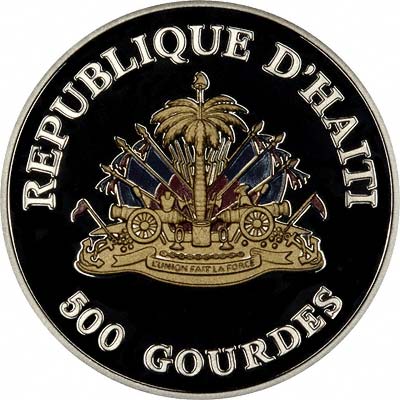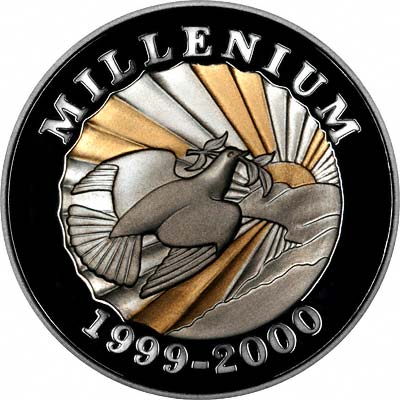| The Very Highest Quality Information... |
| Haitian Coins |
|
| ||||||||||||||||||||||||||||||||||||

| ||||||||||||||||||||||||||||||||||||

| ||||||||||||||||||||||||||||||||||||
Spanish Discovery
Christopher Columbus first discovered Hispaniola in 1492. Following this, the Spanish endeavoured to bring Spanish civilisation to the island, mainly via the process of wiping out the native Taino population and replacing them with Spaniards. The native Taino where decimated by massacre, starvation and disease, to the extent that a population in excess of over 400,000 was almost completely wiped out by the 1530s.
French Colonisation
The Spanish failed to establish their rule over the west of Hispaniola however, and by 1606 had abandoned the area. From 1630, English, Dutch and French pirates began using the Isle of Tortuga, off the north western coast of Hispaniola, as a base for their larcenous activities before expanding onto the nearby coast and founding the city of Hospital. For many years, the area became infamous as a den of thieves, murderers and prostitutes, and generally given a wide berth by honest merchantmen.
The Spanish attempted to retake the land that they had abandoned, but were repulsed, and under the Treaty of Ryswick, the Spanish relinquished their claims over Western Hispaniola to the French. The French established settlements in Ester and Gonaives. The French colonial administration was for a while content to allow the French flibustiers (pirates) to remain in Hospital, viewing them as useful deterrent for English encroachments in the area, but by 1707, began to view them as a liability. The French governor Choiseul-Beaupre forced the Hospital for which the settlement was named to close and most of the inhabitants either left or became farmers.
The area was renamed Port-au-Prince (Port of the Le Prince) after a French ship that sailed into the bay to protect the area in 1706. By 1749, Port au Prince was established as the capital of the colony of Saint-Domingue.
Slavery
Under French rule, Saint-Domingue became one of the most prosperous European colonies in the West Indies, with plantations growing much of Europe's supplies of cotton, indigo, sugar and coffee. To supply labour for these plantations, vast quantities of slaves were imported from Africa. Conditions on these plantations were so brutal that the death rate amongst the slave population was too high to be maintained at the same level without constant replenishment from transatlantic merchants plying their wicked trade.
Although French law in theory protected slaves from being treated with particular cruelty, these laws were typically ignored, and according to one former slave, slaves were routinely subjected to such atrocities as crucifixion, live burial or cremation, crushing, forced coprophagia, castration, boiling and being feasted on by starving dogs. To say nothing of the usual punishments of floggings and beatings. The savagery and cruelty of the planters inspired a visceral hatred amongst the slave population of Haiti, and Saint-Dominigue became a cauldron threatening to boil over with rage.
Independence
The French Revolution of 1789 got a mixed reception in the colony. Many amongst the wealthy white elite viewed the turmoil as an opportunity to declare independence and govern the colony as they liked, unrestrained by Paris. For the same reasons, many amongst the slave and free black community viewed it with some trepidation, as independence would give the planter elite more scope to indulge in even more cruelties against them.
However, the ideals emerging from the French Revolution, notably the idea of egalete (equality) soon checked many of the planters' enthusiasm for events in Paris. Vincent Oge, a free black, travelled to France and breathed the revolutionary air deeply. He was particularly enthused by a law passed by the constituent assembly which granted full civil rights to all men, no matter what their colour. When he returned to Saint Domingue, he tried to insist that the French Governor implement these revolionary policies. However, the governor refused. Oge tried to instigate a revolt against the colonial government, but was soon captured and broken on the wheel (a particularly cruel and unusual form of execution involving being strapped to a wheel and having one's limbs smashed with hammers). The barbarity of Oge's fate was the final straw. In August of 1791, a general revolt was signalled by a voodoo priest named Boukman Dutty, who presided over a ceremony calling for all slaves to revolt against their masters and take the colony for themselves.
The revolt lasted until 1804, during which Napoleon attempted to invade and reimpose slavery, an attempt which ultimately failed. Rebel leader Jean-Jacques Dessalines subsequently renamed the colony Haiti, after the indigenous Arawak name for the island of Hispaniola.
Jacques I
Dessalines proclaimed himself as Emperor of Haiti in 1804. That same year, he ordered a general massacre of all white men, women and children. They were prevented from simply leaving because Dessalines, a former slave himself, feared that they would convince the white powers to invade Haiti again and reimpose slavery. This unspeakable atrocity was ordered to be carried out with clubs and knives, to prevent further victims from being forewarned about what was going on. Dessalines personally visited each major town and city in Haiti to ensure that his orders were carried out. False amnesties were declared to bring more whites out of hiding, and they too were butchered. Once this atrocity had been carried out, almost the entire white population had been wiped out.
Jacques I Dessalines was assassinated in 1806 by disgruntled officials who grew increasingly tired of his brutal policies, some of which seemed little better than those which existed under French colonial government.
Post Revolution
The conspirators in the assassination of Dessalines, Henri Christophe and Alexandre Petion, subsequently divided Haiti into two portions. Christophe took the North and Petion the South. Christophe's state established a system that in many respects resembled the regime that had existed in French colonial times, with labourers forced to work on plantations under conditions little different than those under slavery. Petion on the other hand, divided the land into parcels for the Haitians to work the land for themselves. Although nobler and fairer, this was a much less efficient method of working the land, and the Southern Republic of Haiti remained on the brink of bankruptcy. In 1811, Christophe declared himself King of the feudal state he had created and reigned as Henry I. He committed suicide in 1820 when a coup threatened to overthrow him. Jean Pierre Boyer, Petion's successor as president of the south (Petion had died in 1816) reunited the two Haitis.
In 1821, neighbouring Santo Domingo declared independence from Spain, and Boyer almost immediately occupied the former colony. The island of Hispaniola remained under Haitian control until 1844, when a revolt led to Santo Domingo remerging as the independent Dominican Republic.
In return for recognition from France for Haitian independence in 1840, Bowyer was forced to agree to pay a huge indemnity to French citizens and their heirs who had lost property as a result of the Haitian Revolution. This crippled Haiti's finances, and did not bring forth the level of foreign investment and trade that Bowyer had hoped might have offset the cost of this.
In the 1840s Boyer was overthrown and for a time, Haiti was thrown into anarchy. However, by the 1870s, some measure of stability and prosperity was restored by the development of industrial sugar production methods.
20th Century
This prosperity and stability did not last however, and during the 1910s, Haiti once again began to slide into anarchy. In 1915, US business interests began to be threatened, and US President Woodrow Wilson ordered the invasion and occupation of Haiti to ensure 'responsible government'. This occupation lasted until 1934. Revolts against US occupation were brutally suppressed, but infrastructure was greatly improved.
Stable government did not last long however, and a series of dictatorships, coups and unstable governments plagued the country until Francois Duvalier, a former Health minister, came to power in 1957. Known as 'Papa Doc', Duvalier ruled Haiti with an iron fist, supported by the US on account of his staunch anti-Communist credentials. He ruled until his death in 1971, and was succeeded by his 19 year old son, Jean-Claude Duvalier ('Baby Doc'). Under Baby Doc, Haiti's government degenerated into profiting through drug trafficking and illegally harvested body parts, until he was overthrown in 1986 and democracy restored.
Haiti Today
Haiti was hit by a massive earthquake in 2010, which killed 316,000 Haitians in and around Port-au-Prince and rendered many more homeless. This disaster was followed by a cholera epidemic made worse by the devastation which killed thousands more. Haiti is still struggling to recover from these disasters.
Coinage of Haiti
The first coins used in Haiti were those of the Spanish Dollar, which predominated in the Caribbean for much of the 16th, 17th and 18th Centuries. During French colonial times, the pre-revolutionary French livre was used. The livre was replaced by the Haitian gourde in 1813 and was worth 8 livres 5 sou upon its introduction. The first coins of the gourde were silver 6, 12 and 25 centimes. 50 and 100 centimes were later issued in 1827 and copper 1 and 2 centimes the following year. In 1863, bronze coins of 5, 10 and 20 centimes were issued, struck at the Heaton Mint in Birmingham.
The gourde was revalued in 1870 at 10-1. Only banknotes of this reformed gourde were issued.
In 1872, the gourde was revalued at 300-1 after further catastrophic inflation. In 1881, coins were issued once again in denominations of 1, 2, 10, 20, 50 centimes and 1 gourde. The 5 centimes piece was reintroduced the following year. Coin production ceased in 1908 and did not start again until 1949.
Today, coins of 50 centimes, 1 and 5 gourdes are issued for use in circulation.
For Sale and Wanted
If you are interested in coins from Haiti please see our product index:-
Haitian Coins
| ...at the Lowest Possible Price |
|
32 - 36 Harrowside, Blackpool, Lancashire, FY4 1RJ, England.
Telephone (44) - (0) 1253 - 343081 ; Fax 408058; E-mail: info@chards.co.uk The URL for our main page is: https://24carat.co.uk |
Web Design by Snoop |